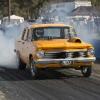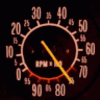Are harmonics killing my engine?
#101
 _Dansthemanow_
_Dansthemanow_
Posted 26 November 2013 - 05:20 PM
#102
 _Dansthemanow_
_Dansthemanow_
Posted 26 November 2013 - 08:13 PM
#103
 _Agent 34_
_Agent 34_
Posted 27 November 2013 - 07:44 PM
OK,
mines back together and no real sign of damage or other issues. The bolts looked fine fingers crossed.
on a side note i got a 202 blue for 200 hundred that i'm going to strip down and start a build process with the crank.
#104
 _Dansthemanow_
_Dansthemanow_
Posted 29 November 2013 - 10:49 PM
I found some really interesting stuff written by rolls royce engineers back in the fifties,regarding their efforts to improve smoothness and crankshaft reliability in their inline six engines.They found that,even with a correctly functioning damper,they could essentially destroy the crankshaft within 3 minutes of running once the crankshaft was in the 3rd order harmonic.One test crank was cracked in 3 places after such a test.They also found that during actual running,they could witness 20 thou of flywheel runout on an engine with zero runout when checked under normal circumstances,and that the crank actually lengthened and shortened in a concertina effect as a result of the forces applied to the crank during actual running of the engine.Would you also beleive that they found the actual clutch disc to give the greatest imbalance of the entire crankshaft system,including flywheel and pressure plate! In other words,you can have a perfectly balanced flywheel and pressure plate,but it could be out of balance once you install the actual clutch disc.
But one usefull thing they said was in relation to engine overrun,which they say is highly stressful to the crankshaft.I pasted a quote from the article:
A largely unknown danger is over running of the engine from medium or higher speeds, it is destructive to many engine components. Most owners may have attained a higher engine rpm in an intermediate gear than they have in top gear, sometimes unwittingly, when descending a steep incline. If a downward gear change is undertaken and, particularly if heavy braking immediately follows this, the stresses caused by torsional reversals can be tremendous. The engine can be required to go from full or nearly full gas load above the pistons at a high power demand to a no gas load situation and full over run. Whenever fairly high powers or speeds are demanded it is a wise driver who avoids excessive and sudden engine overrun.
It is the suddenness of this action, the instantaneous engine speed change, combined with reversals that are so destructive. In any event, radial spring drive springs in a seized damper will be subject to hammering and will not survive this treatment for long, and neither will the fingers of the damper spring pressure plate, which have to transmit damper torque.
Analysis of the company crankshaft breakage tests and the few service breakages indicate that the most damage was done in the quickest time, in engine overrun conditions.
I did notice with my engine that the loose flywheel only buzzes about once you back off at high rpm.Under load it does not rattle about on the end of the crank,even with loose bolts.Its probably the overunning which causes it to come loose in the first place.So I think how you actually drive the car could be as important as anything else in preventing vibration related problems.
#105
 _Dansthemanow_
_Dansthemanow_
Posted 01 December 2013 - 11:47 AM
#106

Posted 02 December 2013 - 05:46 AM
The other problem with the Hemi 6, is the flywheel isn't attached to the crank with a spigot.
#107

Posted 02 December 2013 - 07:47 AM
#108
 _Dansthemanow_
_Dansthemanow_
Posted 02 December 2013 - 08:42 PM
yeah,well no spigot would make it a lot harder to keep the flywheel tight.And the big snout would allow a balancer that size.You wouldnt dare put some hunk that size on the end of the holden motor unless you wanted to see it come through your bonnet and land god only knows where!
Im at this point thinkng ill probably remove my motor and just pull the crank,leave the top end untouched as its all low mileage.Im gonna get the crank crack tested and make sure its still straight.That way ive got peace of mind.Put in 3 dowels as its gonna be just as easy to do that than get a custom jig made up and muck around going to 7/16 bolts.With the dowels the larger bolts just wont be needed,provided the harmonics are reasonable.I can re gasket the bottom end and give the block a lookover and a lick of fresh paint while im at it.
I may try greens fluidampr on there, so I can modify the timing cover while its all apart.Otherwise you cant really refit the timing cover properly without loosening off the sump.I think the fluidampr is good at lowish rpm so would suit my stroker.The other thing is that rubber dampers are frequency sensitive,and unless they are custom designed by someone who knows all your engine specs,its gonna be hit and miss as to wether it actually works for your particular motor.Being big is one thing,but that alone doesnt tell you its gonna work at your engines natural frequency.The fluidampr will work to a reasonable degree at any frequency so its not such a hit or miss afair.Having said that , I hear they are not so good at high rpm i.e above 6k or so.So maybe high reving motors are better of with a rubber band damper.
I might go to a 8.6 kg wheel.At least im going a bit heavier,still shying away from going back to stock weight just cos I run it around a circuit and in the hills a bit and want to keep the response bit better.
Bottom line is I just dont think
#109
 _Dansthemanow_
_Dansthemanow_
Posted 02 December 2013 - 08:58 PM
Sorry,as I was saying,I just dont think really hot sixes should be put into service without some dowels on the flywheel.It should be mandatory for all >6k engines.Some people seem to get away with it,even mine lasted for a fair while before it came loose.But sooner or later its gonna happen.Also some of these aftermarket balancers may not be delivering the goods.A lot of fancy marketing i.e billet this, SFI rating that, but do they know if its gonna work on your engine after every things been changed from standard.Like I said, If the balancer is not tuned to your specific engines resonances,its essentially useless.BJH is another company that will custom design,but they ask for everything including CAD drawings of your crank to make sure they can predict what the natural frequency of you motor will be.Its just too complex to estimate what might or might not work.In the end your just guessing.So either you go through the trial and error of pulling gearboxes and cranks everytime it doesnt work,or you spend a thousand bucks and get a balancer made that has been calculated to suit your engine.Or go for the fluidampr which is not so frequency sensitive,but again has to have a custom hub for the holden.
#110

Posted 11 December 2013 - 06:22 AM
We are using a 3.3 black, 11.4 :1 comp, YT 8.6 kg flywheel, 7/16" V8 bolts, 2 dowels & powerbond balancer,and yes, the flywheel has come loose yet again ! Coincidentally, Wayne Mahnken happened to call in the other day.... his advice, " get one of Graham Withers' balancers.....that'll fix it ! ".......
#111
 _Agent 34_
_Agent 34_
#112
 _Dansthemanow_
_Dansthemanow_
Posted 21 January 2014 - 02:07 PM
Another tip,NEVER allow any kind of thread lock or retaining compound to get on the crank flange.It just acts like lubricant rather than help hold it.
#113
 _Dansthemanow_
_Dansthemanow_
Posted 30 March 2014 - 10:21 AM
Only thing is now i got a 30mm long crack forming just behind the starter motor,level with the coolant drain bung.Coolant weeping out!
Might have to put some grout in the block to cover the crack.I aint keen to pull the motor,again.Its either patch it up,or it can sit for 6 months while i have a break!
#114
 _Agent 34_
_Agent 34_
Posted 30 March 2014 - 12:25 PM
Dan that's a bummer with the crack.
any photos of the offending part or crack. Would be interested to see where this crack is and other smarter people than me would be able to comment on this.
My understanding ( as i have not seem one) is that it cracks between the welsh plugs on the passenger side. I could be wrong with this one as well.
G
#115
 _Bluejinx202_
_Bluejinx202_
Posted 30 March 2014 - 01:38 PM
#116

Posted 30 March 2014 - 03:00 PM
I have also cracked the 208 block once vertically between the 3rd and 4th pot water jacket, was about 5 inches long
#117
 _Agent 34_
_Agent 34_
Posted 30 March 2014 - 05:15 PM
A big washer ?
i was going to do the " locking tabs" but didn't
#118

Posted 30 March 2014 - 05:20 PM
That's it Grant,
A big washer with the crank to flywheel fastening holes in it
#119
 _Dansthemanow_
_Dansthemanow_
Posted 30 March 2014 - 06:07 PM
They are known to crack between welsh plugs, but apparently its also not uncommon for a horizontal crack to form just behind the starter motor.I already stripped the manifolds n starter to look at it. Just a fine horizontal line with some coolant leaking from it.
I already know welding is futile and best avoided.But as Bluejinx said, you can use "metal stitching" with special threaded pins to repair cracks in cast iron.Supposedly its quite effective and gives a sound repair.I may go down that path.Apparently you can repair such a crack in about an hour with that technique.
Btw,Bluejinx, u know who sells kits to perform the metal stitching, or do you get a pro to do the job for you?
#120
 _Bluejinx202_
_Bluejinx202_
Posted 31 March 2014 - 10:27 AM
#121
 _Ned Loh_
_Ned Loh_
Posted 01 April 2014 - 01:26 PM
Myself and a few of my marine 202 mates know block cracks well. Our standard setup has cold water in the front and hot water out the back so thermal shock and heat expansion are fairly common for us. Exterior water jacket cracks are fairly easily sorted by drilling and tapping bolts down the crack, several in a row overlapping as you go so each thread finishes as a half moon. Grind smooth and brush on paint
Hi James,
Has this been tried on a 'typical' crack between the welch plugs?
Wonder if using that 2.8 block you have at less than 3.6" bore would help.
Cheers.
#122
 _Agent 34_
_Agent 34_
Posted 01 April 2014 - 05:49 PM
I keep saying that " i'm no expert " and i'm not BUT
with my block it was grout filled to the bottom of the water pump opening , front of engine.
Whilst this may or may not be above or below the crack line.
Again - i have never put grout into a block,
would this not seal up the crack as well ? depending on the height of the crack.
Heating is not an issue with the grout filled block to this level as i run a triple core radiator.
so it's just an option which the motor may be able to stay in the car.
I'm no expert - ps I'm changing my avatar message to this LOL
G
#123
 _202DOHC_
_202DOHC_
Posted 01 April 2014 - 09:19 PM
to cut the thread. I have attached the web address for the manual. If installed correctly they work really well.
www.irontite.com/PDF/crack-detect_manual.pdf
Edited by 202DOHC, 01 April 2014 - 09:27 PM.
#124
 _Agent 34_
_Agent 34_
Posted 02 April 2014 - 06:08 PM
Can we pin this thread please. would be also cool to link Warren M, thread on his harmonic ballancer on this link as well.
I have it pinned as a thread. I'll Pm datto and see.
G
#125

Posted 03 April 2014 - 11:24 PM
Wow Grant,
You got the Thread Pinned, well done. Dave I
1 user(s) are reading this topic
0 members, 1 guests, 0 anonymous users




 View Garage
View Garage











